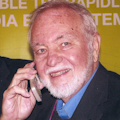National Instruments, the LabVIEW company, has a new education product that should really make EE lab work in colleges and universities faster and easier. And the students will love it as much as the professors. It is the NI myRIO, a programmable module that lets students build complete systems.
EE labs, if there are any for a course, are usually cobbled together with a mix of hardware and software compiled by the instructor who also develops some lab experiments or projects. The ease of use and effectiveness of the lab assignments vary widely. Yet, it is important to provide some actual, real world hands on learning to give the student some inkling of what it will actually be like on the job.
Labs in early courses focus on circuits and components. These can be implemented with NI’s previous educational products like the ELVIS trainer or the hand held myDAQ. The myDAQ is a complete low cost package that implements virtual instruments through LabVIEW and includes power supplies, signal sources and breadboarding capability with plenty of analog and digital I/Os. NI introduced the myDAQ a few years ago and already hundreds of schools are using it to provide students lab experience. And the students can do the lab work themselves on a laptop with the myDAQ anywhere anytime instead of having to go to a lab at a specific time. What the myDAQ lacked is a way to do advanced digital and programming projects.
As EE education continues to move from a strictly circuit-oriented focus to one featuring more systems, it becomes more difficult to create meaningful lab activities. The new myRIO solves this problem. The myRIO is a spinoff of NI’s popular CompactRIO product, a modular reconfigurable embedded control and data acquisition system. It includes a wide range of I/O modules, a reconfigurable FPGA chassis and an embedded controller. The whole thing is programmed via LabVIEW. You can build almost any possible embedded system. The myRIO crams all of this into a roughly 5.5 by 3.5 inch module.
The heart of the myRIO is a Xilinx Zynq which includes a 32-bit dual-core ARM Cortex A9 processor and an FPGA with 28,000 programmable logic cells. The memory is 256MB of flash and 512MB DRAM. It has multiple analog I/O connections including one for a 12-bit ADC as well as audio input and output. Also present are multiple digital I/O lines including GPIO, UART, PWM, SPI and I2C. The unit connects to a host computer via a USB 3.0 port or by 802.11g/n Wi-Fi. Power is by an AC/DC power supply but it will also run from 8 AA cells making it suitable for portable applications. The Wi-Fi is a blessing in portable uses. A unique feature is a 3-axis accelerometer. All programming is with LabVIEW; however, you can program the embedded controller in C/C++. The myRIO also has a screw terminal connector with external connections similar to that on the myDAQ. This lets you connect to an external breadboard and NI’s mini-systems, small applications.
While the myRIO is useful in many EE courses, it can also be used in mechanical engineering and other non-EE courses. Examples included data acquisition with sensors, controls, mechatronics, embedded systems and senior/graduate projects. The device and LabVIEW are easy to learn so the learning curve is short.
The myRIO is a cool device. And the good news is that students can buy it for only $250. And that includes LabVIEW. That is a lot of hardware and software for the money. Some related course materials are available for download now but I suspect lots more will be forthcoming as professors and students begin to use this versatile product. I’m looking forward to getting one myself to play with. Take a look at www.ni.com/myrio.
About the Author

Lou Frenzel Blog
Communications Technology
Click here to find more of Lou's articles on Electronic Design.